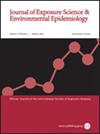Associations of climatic factors with pregnancy loss in Nicosia, Cyprus
IF 4.7
3区 医学
Q2 ENVIRONMENTAL SCIENCES
Journal of Exposure Science and Environmental Epidemiology
Pub Date : 2025-05-22
DOI:10.1038/s41370-025-00781-3
引用次数: 0
Abstract
While ambient climatic factors are linked to adverse pregnancy outcomes, only a few studies examine the risk of pregnancy loss. This study aims to examine the effects of climatic factors on pregnancy loss in Nicosia, Cyprus, an area that is highly affected by climate change. Birth registry data obtained from maternity units in Nicosia from 2014–2019 were linked with daily meteorological and traffic pollution data (minimum and maximum temperature, °C; relative humidity [RH], %; and nitrogen dioxide [NO2], μg/m3). We also estimated other climatic factors from the obtained data (mean weekly temperature, standard deviation of weekly temperature and RH [temperature and RH variability], and heat index [HI]). We used a novel variation of time-series design and distributed lag models adjusting for secular trends and air pollution to explore the association between climatic factors and weekly live-birth identified conceptions (LBICs), to indirectly estimate pregnancy losses. There were 26,382 live births over the study period, with an average weekly LBICs of 84.7( ± 12.2). We found an association between exposure to higher temperature between gestation weeks 0–9 and pregnancy loss, with the strongest association in weeks 0–1. Specifically, for a 5°C increase in mean week 0–1 temperature, 3.17 (95% Confidence Interval [CI]: 1.06–5.28) additional conceptions would result in pregnancy losses. A similar effect during early pregnancy was found for exposure to minimum and maximum temperature, HI, and RH. Furthermore, we found that temperature variability may have an impact in later weeks during pregnancy, with the strongest estimate in week 26 (6.70 [95% CI: 0.78–13.21] losses per 5 °C increase in standard deviation of weekly temperature). Similar results were observed for RH variability. This research investigates the link between climatic factors and pregnancy loss in Nicosia, Cyprus, a region experiencing rising temperatures and humidity levels. By analyzing live birth data using a novel time-series approach, the study finds that higher temperatures and humidity levels are associated with increased pregnancy loss, particularly in early gestation. These findings underscore the need for targeted public health interventions, such as heat warning systems, to mitigate the impact of climate change on vulnerable populations. As climate change escalates, understanding these associations is crucial for developing effective strategies to protect maternal and fetal health.

塞浦路斯尼科西亚气候因素与妊娠损失的关系。
背景:虽然环境气候因素与不良妊娠结局有关,但只有少数研究调查了妊娠丢失的风险。目的:本研究旨在研究气候因素对塞浦路斯尼科西亚地区妊娠损失的影响,这是一个受气候变化影响很大的地区。方法:将2014-2019年尼科西亚妇产单位的出生登记数据与每日气象和交通污染数据(最低和最高温度,°C;相对湿度[RH], %;二氧化氮[NO2], μg/m3)。我们还从获得的数据中估计了其他气候因子(周平均温度、周温度和RH[温度和RH变率]的标准差和热指数[HI])。我们使用了一种新的时间序列设计和分布滞后模型来调整长期趋势和空气污染,以探索气候因素与每周活产确定概念(LBICs)之间的关系,以间接估计妊娠损失。结果:在研究期间有26382名活产婴儿,平均每周lbic为84.7(±12.2)。我们发现妊娠0-9周暴露于较高温度与流产之间存在关联,其中0-1周的关联最强。具体来说,0-1周的平均温度每升高5°C,就会导致3.17(95%可信区间[CI]: 1.06-5.28)个额外的怀孕损失。在怀孕早期,暴露于最低和最高温度、HI和RH也有类似的影响。此外,我们发现温度变化可能在妊娠后期产生影响,在第26周估计最强(每周温度标准偏差每增加5°C损失6.70 [95% CI: 0.78-13.21])。RH变异性也观察到类似的结果。影响声明:这项研究调查了气候因素与塞浦路斯尼科西亚怀孕损失之间的联系,该地区正在经历气温和湿度的上升。通过使用一种新颖的时间序列方法分析活产数据,该研究发现,较高的温度和湿度水平与妊娠损失增加有关,特别是在妊娠早期。这些发现强调需要有针对性的公共卫生干预措施,如高温预警系统,以减轻气候变化对脆弱人群的影响。随着气候变化的加剧,了解这些关联对于制定保护孕产妇和胎儿健康的有效策略至关重要。
本文章由计算机程序翻译,如有差异,请以英文原文为准。
求助全文
约1分钟内获得全文
求助全文
来源期刊
CiteScore
8.90
自引率
6.70%
发文量
93
审稿时长
3 months
期刊介绍:
Journal of Exposure Science and Environmental Epidemiology (JESEE) aims to be the premier and authoritative source of information on advances in exposure science for professionals in a wide range of environmental and public health disciplines.
JESEE publishes original peer-reviewed research presenting significant advances in exposure science and exposure analysis, including development and application of the latest technologies for measuring exposures, and innovative computational approaches for translating novel data streams to characterize and predict exposures. The types of papers published in the research section of JESEE are original research articles, translation studies, and correspondence. Reported results should further understanding of the relationship between environmental exposure and human health, describe evaluated novel exposure science tools, or demonstrate potential of exposure science to enable decisions and actions that promote and protect human health.

 求助内容:
求助内容: 应助结果提醒方式:
应助结果提醒方式:


